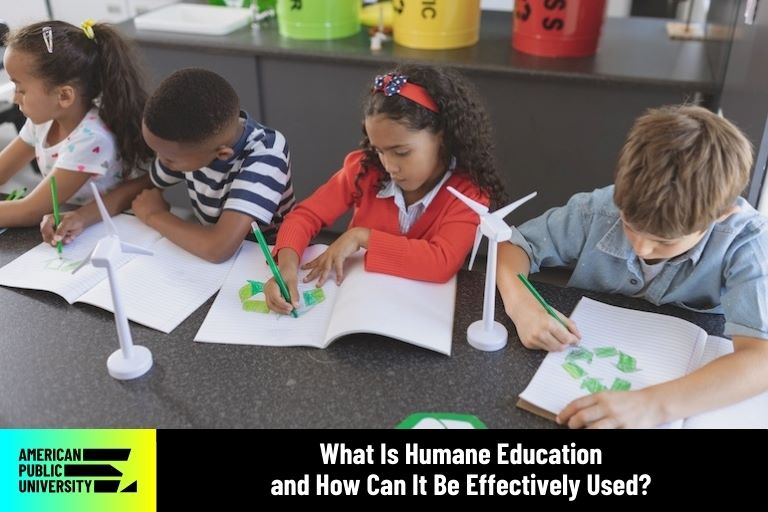By Dr. Kathleen Tate | 05/21/2025

When people think of humane education, they often associate it with humane societies and similar organizations that advocate for the treatment and care of animals. However, the definition of humane education is more expansive.
The Institute for Humane Education (IHE) defines humane education as a “field of study that draws connections between human rights, animal protection, and environmental sustainability.” It prepares people to be solutionaries who identify and address issues associated with humans, animals, and the environment, and propose related solutions.
What Are Solutionaries?
IHE president and co-founder Zoe Weil coined the word solutionary. A solutionary is “someone who identifies inhumane, unjust, and unsustainable societal systems and then develops solutions to transform them so that they do the most good and least harm for people, animals, and the environment."
Weil distinguishes between solutionaries, humanitarians, and problem-solvers. She explains that solutionaries focus on solutions for all who are impacted by a problem while also attending to suffering.
The focus is on changing the systems that cause and/or contribute to the problems. Those problems may be local, regional, or global. By contrast, humanitarians tend to focus on people or animals who suffer, and problem-solvers may not seek to alter systems.
Solutionaries in Education
As instructors, we can prepare children, adolescents, and teens in K-12 schools to be solutionaries. We can incorporate this type of education into a curriculum to help them acquire the knowledge and skills needed to better address global challenges.
Ideally, educators should start early with young people, helping them to develop unique and overlapping global citizenship skills and soft skills. As a result, they will be able to better navigate a world that requires:
- Critical thinking
- Problem-solving
- Collaboration/teamwork
- Adaptability
- Flexibility
- Empathy
- Global awareness
- Social justice
- Interconnectedness
- Knowledge
- Compassion
These ideas align to the U.S. Department of Education’s mission statement, which is “to promote student achievement and preparation for global competitiveness by fostering educational excellence and ensuring equal access.” Addressing various skills through a K-12 curriculum equips learners for the local or global community while developing their understanding of and respect for our planet through science, social studies, language arts, and other topics.
It is time for teachers to become – or at least approach instruction like – humane educators.
The Essential Elements of Humane Education
The IHE has evolved its recommendations for humane education over the years. It has suggested fostering students’ curiosity, creativity, and critical thinking. In addition, this organization has recommended that learners develop reverence, respect, and responsibility and offered resources to solve educational challenges.
More recently, the IHE notes that humane educators should help learners to:
- Acquire knowledge
- Be enthusiastic, effective researchers who obtain accurate information about interconnected local and global challenges
- Discern facts from opinion and conjecture
- Think deeply by developing their critical, strategic, and creative thinking skills
- Make compassionate and responsible choices by fostering wonder and appreciation for the natural world
- Develop empathy for living beings such as people and animals
- Commit to doing the most good and least harm
- Focus on solutions by providing opportunities to collaboratively engage in problem-solving
- Implement ideas and assess and improve upon them as needed
If you are a teacher reviewing this list, instant connections to disciplines you teach will likely emerge. For example, research and information literacy along with evaluating fact versus opinion are common state and national standard expectations in language arts with some overlap in social studies.
Deep and critical thinking applies to studying literature, history, science, and other subjects. Empathy and compassion for people and animals aligns to fiction, non-fiction, and other genres in language arts. They are also connected to social studies (such as child labor, slavery, and poverty) and science (such as endangered species, ethical treatment of animals, and animals’ reliance and interactions within ecosystems).
The problem/solution element of humane education is similar to young learners’ exploration of the plot of a story or the narrative genre in language arts. They must identify and analyze problems and solutions, as well as characters’ related interactions and their influence. There is a parallel with how professional artists, engineers, scientists, and historical figures across art, science, and social studies work with problems and solutions.
How to Incorporate Humane Education into a Curriculum
When you are planning to infuse this type of education into student instruction, you should start by choosing one curriculum standard in a subject area. Begin with a simple topic that you are passionate about as enthusiasm is catching among your learners.
Your topic may be related to human beings, animals, or the environment. More complex topics – such as animal cruelty, factory farming, and social change – could be saved for later.
Think of a few ideas within your area of interest and then share your ideas with your students. Perhaps the entire class could focus on one endeavor. Another option would be to have your learners break up into groups and focus on sub-areas of your topic, based on their choices and interests.
Next, make sure that the topic is age-appropriate. We do not want to frighten young learners, but we do want to teach them about local or world problems to which they can relate and create a more personalized learning experience. At the same time, these learners should develop empathy and respect while they practice kindness and feel a sense of hope and empowerment.
I once wrote a humane education article about teacher education majors. One pre-intern was an elementary school field student who helped the entire school collect shoes after a Haiti earthquake. Another field student helped pre-K children write and illustrate small poster-sized letters to persuade the U.S. Secretary of the Interior at the time to help save polar bears through legislation.
These approaches were grounded in the state curriculum standards, but through meaningful, purposeful hands-on activities. These experiences helped develop each student’s sense of compassion and showed them how their actions could affect humans and animals. It gave them hope for the future as they learned they could take meaningful action steps, even at their young ages.
Leveraging Resources
When you are incorporating humane education into your classroom, make sure to use information from the IHE or another established organization to teach students about this type of education. Your learners will need to know humane education’s definition and components. They will also need to understand its purpose and see examples of what other children, adolescents, or teens have accomplished.
When planning to create the first humane education experience for K-12 learners, you may also want to reach out to local or national experts who may provide materials, ideas, and information.
For example, you could:
- Email or phone someone at an animal shelter, an animal rescue group, a zoo, or animal sanctuary
- Contact a professor of environmental science
- Find a person who works at a food bank to help with learning about various needs and resources
There are humane education books and websites. They can provide materials and ideas that will help teach students social responsibility and ways to positively affect the natural world.
You may want to start after-school programs such as clubs that focus on the earth, animals, or humans to extend learning beyond the classroom. In addition, school and public librarians are great sources for recommending books and other materials on various animal, human, or environmental topics. Their recommendations can be based on students’ grade level or reading level.
Educational Materials Should Be Carefully Chosen
It is important to recognize that some organizations may not be a good fit for a classroom project. For example, if some of your students are experiencing homelessness or hunger, it may be awkward to focus on a project that involves a homeless shelter or food bank.
Also, it is useful to be aware and informed about your students’ lives. When you are selecting a humane education topic and project, try to include those students and maintain their dignity.
Now Is the Time to Become a Humane Educator
If you have not already done so, now is the time to investigate and begin thinking like a humane educator. Take a chance and try it in one lesson plan at first.
K-12 students deserve deeper, more purposeful learning activities that turn into action steps beyond the classroom walls and to develop lifelong skills that will help them in any field. We need well-prepared global citizens to enter the workforce after school or college who care about lives and the world in which they live.
The Bachelor’s Degree in Human Development and Family Studies
For students interested in acquiring the knowledge to become educators, American Public University (APU) offers an online Bachelor of Arts in Human Development and Family Studies. Major required courses in this program include an introduction to child development, child and adolescent development, and human life span development.
Students also have the option of choosing several concentration courses that suit their professional interests. Learners may also choose from multiple general education courses such as “Humane Education: A Global, Interdisciplinary Perspective” and “Information and Digital Literacy.”
For more information about this bachelor’s degree and other educational programs, visit APU’s degree program page.
Note: This program does not award professional licensure and does not qualify you to apply for teaching licensure. This program may be helpful in preparing to earn certain professional certifications.
Also, individual states/professional organizations often require additional hands-on training, internships, or site visits not provided by our University. It is your responsibility to become familiar with all licensure/certification requirements in the state in which you plan to seek employment or from the certification body.
Dr. Kathleen J. Tate is a Professor and Department Chair of Teaching in the School of Arts, Humanities, and Education at American Public University. She is an experienced university administrator, researcher, and the former Editor-in-Chief of the Journal of Online Learning Research and Practice (2016 – 2024). Dr. Tate is also the author of a children’s book “Melvin and Muffin: Physics on the Playground (Exploring Newton’s 3rd Law),” studied six languages, and is proficient with Braille.
She recently published “My Science Journal: A Daily Science Log Featuring Melvin & Muffin,” “My Science Journal: Blank Journal Featuring Melvin & Muffin,” and “Friend Journal: Fill-in-Book for Adults”. Dr. Tate maintains a website she created for educators, families, and children.
Dr. Tate has 28 years of experience working in higher education (Research I, online/hybrid, and other institutions) and K-12 special education, in addition to corporate, civil service, and retail experience. She has chaired and served on dissertation and Ed.S. committees, mentored faculty members, written and received internal and external grants (science education/technology education), and developed curriculum, especially integrating technology.
She holds a B.A. in Soviet and East European Studies with a minor in Economics and a M.Ed. in Special Education from the University of Texas at Austin. In addition, Dr. Tate has several lifetime Texas teacher licenses (1st-8th Elementary Education, PK-12th Special Education, and 1st -8th Theatre Arts) through the University of Texas at Austin. She has a Ph.D. in Elementary Education from Florida State University.
Dr. Tate's research focuses on underserved populations, humane education, integrated/thematic/arts-based/multimodal teaching and learning, and STEAM (STEM + the arts). She served on the Curriculum Advisory Board for the Institute for Humane Education from 2019-2023. Dr. Tate has published articles in Teacher Education and Practice, Social Studies Research and Practice, Youth Theatre Journal, Science and Children, GATEways to Teacher Education, and the Journal of the Research Association of Minority Professors, to name a few.

